|
|
|
Sort Order |
|
|
|
Items / Page
|
|
|
|
|
|
|
| Srl | Item |
| 1 |
ID:
173390
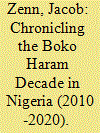

|
|
|
|
|
| Summary/Abstract |
Boko Haram videos are among the only windows into the group leadership’s ideology. However, previous studies of Boko Haram videos treated the group monolithically and neither distinguished between internal factions nor analyzed cinematographic settings in each faction’s videos. At a time when the two groups known as Boko Haram–Islamic State in West Africa Province (ISWAP) and Jamaat Ahlussunnah lid-Dawa wal-Jihad (JAS)–rival each other and combat Nigerian and subregional military forces, this article argues it is imperative to examine factions’ contrasting self-presentations in videos. While one faction led by Abu Musab al-Barnawi revealed combat skill and lectured about an Islamic state, another faction led by Abubakar Shekau revealed veneration of Shekau, masses of worshippers in group territories, and imposing sharia punishments. Even when these factions were nominally unified, they still produced media separately and competed to control communications to Islamic State. Another Boko Haram breakaway group called Ansaru also influenced Boko Haram videos after some members reintegrated into Abu Musab al-Barnawi’s faction. This article demonstrates how in jihadist groups the one wielding the camera also wields power and how jihadist videos can facilitate understanding a group’s internal dynamics.
|
|
|
|
|
|
|
|
|
|
|
|
|
|
|
|
| 2 |
ID:
104277
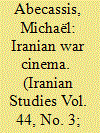

|
|
|
|
|
| Publication |
2011.
|
| Summary/Abstract |
The fascination for the Western world with Iranian cinema lies primarily with the fablelike
developments of its stories which often plunge us into a world of exoticism and lured us
with its singularity. Iranian war cinema born during the war between Iran and Iraq is not
as well distributed in Europe and films with English subtitles are difficult to get hold of.
Whether it is interpreted as an anthropological document which opens a dialogue between
the protagonist and the spectators, the "I" and the other, Iranian war cinema by Tabrizi,
Sinayi, Hatamikia and Ghobadi, among many others, can be seen as a spiritual voyage
where the soul hovers between absence and presence. In the wake of war cinema in
general, one can draw parallels with mythology, the Judeo-Christian tradition,
literature and art. Its function is not only didactic but cathartic, and the particularity
of Iranian war cinema like no other is that it participates in the mourning process of a
whole nation fighting against its own ghosts and in search of its identity. This article
attempts to decipher the myths hidden behind the images presented by Iranian war
cinema, paradoxically interweaving the traumatic with the aesthetic.
|
|
|
|
|
|
|
|
|
|
|
|
|
|
|
|
| 3 |
ID:
192657
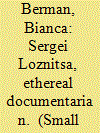

|
|
|
|
|
| Summary/Abstract |
On 24 February 2022, Russia launched a full-scale invasion of Ukraine in a major escalation of a war that had been persisting since 2014. This article explores three of Sergei Loznitsa’s films set in Ukraine and examines the way in which their shared observational style informs the Russia-Ukraine war and may influence viewers’ perceptions of the complexities of the conflict. A close analysis reveals that the observational mode used in Maidan (2014), Donbass (2018), and The Kiev Trial (2022) has two primary effects. First, in Donbass and The Kiev Trial, the unfiltered style serves as a contrast to the often farcical and ‘staged’ content, thereby exposing the lies underpinning Soviet presence in Ukraine and the current Russian invasion. Second, in addition to exposing Russian misinformation, Loznitsa’s observational style in Maidan and Donbass facilitates identification with the Ukrainian people by visually and auditorily immersing the viewer in the world on the screen. The article concludes with a discussion of the significance of Loznitsa’s work in shaping the public’s perception of – and continued commitment to – the war in Ukraine.
|
|
|
|
|
|
|
|
|
|
|
|
|
|
|
|
| 4 |
ID:
124470
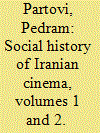

|
|
|
|
|
| Publication |
2013.
|
| Summary/Abstract |
Hamid Naficy has finally rewarded readers with his long-planned and eagerly anticipated multi-volume history of Iranian cinema. The first two volumes reviewed here, covering the late Qajar and Pahlavi eras (1897-1978), were first published in September 2011. The third volume, subtitled "The Islamicate Period, 1978-1984," reached press in late spring 2012. The fourth and final volume, on "The Globalizing Period, 1984-2010," was published in November 2012. The sheer size of Naficy's undertaking signals its importance to the field and to the author. It is in many ways a life's work. In fact, the biographical preface to the first volume describes a lifelong engagement with cinema that has informed this project. Naficy presents the end product as the culmination of nearly four decades of research and writing. But his personal investment in the work is not the sole justification for it. Within its pages, Naficy forcefully makes a case for cinema's centrality to Iranian life-its images, voices, and ideas pushing and pulling a society in transition towards and away from modernity.
|
|
|
|
|
|
|
|
|
|
|
|
|
|
|
|
| 5 |
ID:
190719
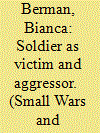

|
|
|
|
|
| Summary/Abstract |
This article examines the subversion of the hero soldier figure in three Vietnam War films from three different nations that faced defeat in Vietnam: Coppola’s Apocalypse Now, Schoendoerffer’s Dien Bien Phu, and Jeong Ji-yeong’s White Badge. A close analysis reveals that all three films undermine the image of the virtuous and powerful hero soldier through recurring stylistic elements. Apocalypse Now, through the ‘Ride of the Valkyries’ helicopter sequence – as well as the opening and ending sequences – portrays the American soldier as a barbaric aggressor. Dien Bien Phu, meanwhile, visually undermines the image of the powerful hero soldier through cinematographic techniques which portray the French soldiers in the field as small and powerless. Finally, White Badge – which, unlike the two other films, takes place in the post-war period – subverts the image of the hero soldier through its use of auditory and visual elements to portray the Korean soldier as aggressor and, first and foremost, victim. The article concludes with a discussion of how the three films influence audiences’ perceptions of those who fought in Vietnam.
|
|
|
|
|
|
|
|
|
|
|
|
|
|
|
|
|
|
|
|
|